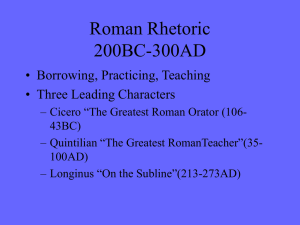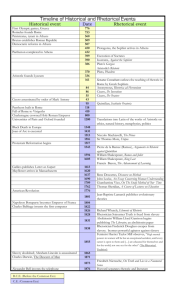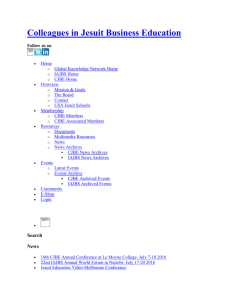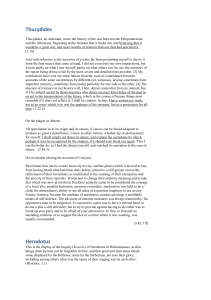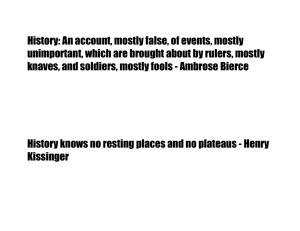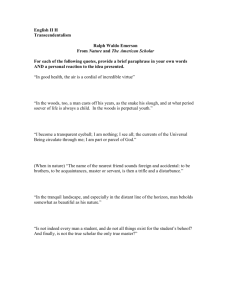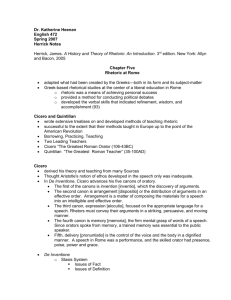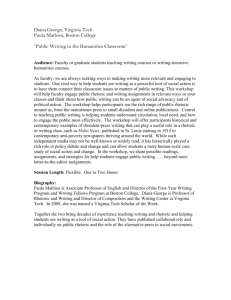Jesuit Renaissance Humanism
advertisement
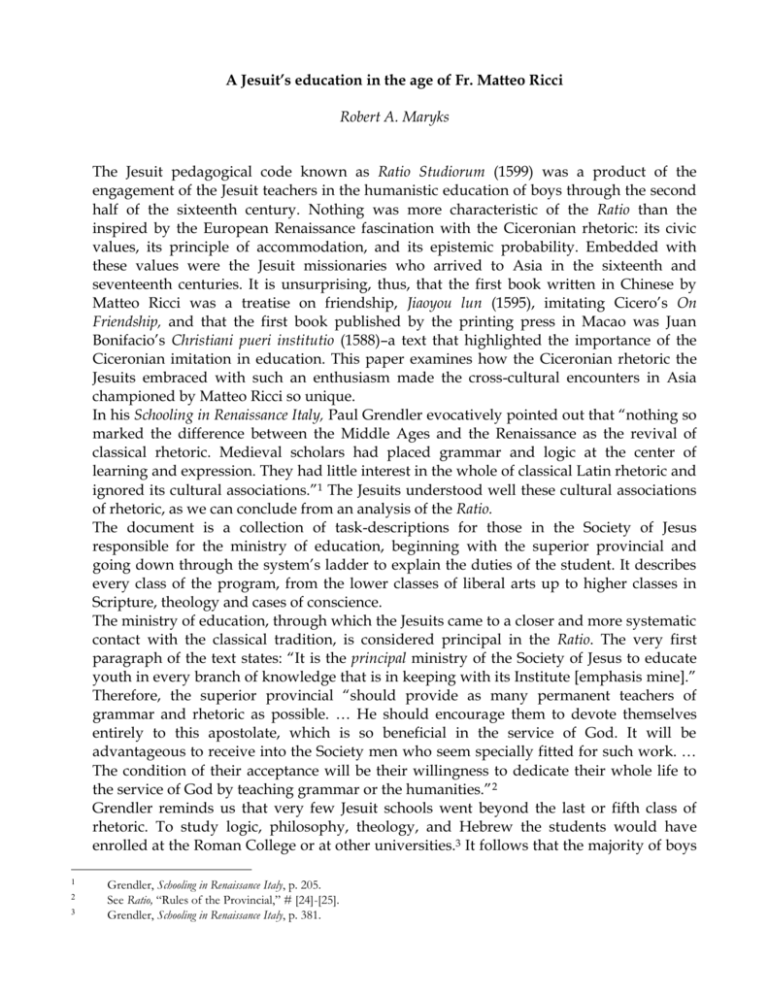
A Jesuit’s education in the age of Fr. Matteo Ricci Robert A. Maryks The Jesuit pedagogical code known as Ratio Studiorum (1599) was a product of the engagement of the Jesuit teachers in the humanistic education of boys through the second half of the sixteenth century. Nothing was more characteristic of the Ratio than the inspired by the European Renaissance fascination with the Ciceronian rhetoric: its civic values, its principle of accommodation, and its epistemic probability. Embedded with these values were the Jesuit missionaries who arrived to Asia in the sixteenth and seventeenth centuries. It is unsurprising, thus, that the first book written in Chinese by Matteo Ricci was a treatise on friendship, Jiaoyou lun (1595), imitating Cicero’s On Friendship, and that the first book published by the printing press in Macao was Juan Bonifacio’s Christiani pueri institutio (1588)–a text that highlighted the importance of the Ciceronian imitation in education. This paper examines how the Ciceronian rhetoric the Jesuits embraced with such an enthusiasm made the cross-cultural encounters in Asia championed by Matteo Ricci so unique. In his Schooling in Renaissance Italy, Paul Grendler evocatively pointed out that “nothing so marked the difference between the Middle Ages and the Renaissance as the revival of classical rhetoric. Medieval scholars had placed grammar and logic at the center of learning and expression. They had little interest in the whole of classical Latin rhetoric and ignored its cultural associations.”1 The Jesuits understood well these cultural associations of rhetoric, as we can conclude from an analysis of the Ratio. The document is a collection of task-descriptions for those in the Society of Jesus responsible for the ministry of education, beginning with the superior provincial and going down through the system’s ladder to explain the duties of the student. It describes every class of the program, from the lower classes of liberal arts up to higher classes in Scripture, theology and cases of conscience. The ministry of education, through which the Jesuits came to a closer and more systematic contact with the classical tradition, is considered principal in the Ratio. The very first paragraph of the text states: “It is the principal ministry of the Society of Jesus to educate youth in every branch of knowledge that is in keeping with its Institute [emphasis mine].” Therefore, the superior provincial “should provide as many permanent teachers of grammar and rhetoric as possible. … He should encourage them to devote themselves entirely to this apostolate, which is so beneficial in the service of God. It will be advantageous to receive into the Society men who seem specially fitted for such work. … The condition of their acceptance will be their willingness to dedicate their whole life to the service of God by teaching grammar or the humanities.”2 Grendler reminds us that very few Jesuit schools went beyond the last or fifth class of rhetoric. To study logic, philosophy, theology, and Hebrew the students would have enrolled at the Roman College or at other universities.3 It follows that the majority of boys 1 2 3 Grendler, Schooling in Renaissance Italy, p. 205. See Ratio, “Rules of the Provincial,” # [24]-[25]. Grendler, Schooling in Renaissance Italy, p. 381. 2 trained by the Jesuits received a more humanistic than philosophical or theological training. Crucial in this humanistic training was classical rhetoric that Ratio established pivotal in the Jesuit educational system. The purpose of the class in rhetoric was “the development of the power of self-expression. Its content spans two major fields, oratory, and poetry, with oratory taking the place of honor. The purpose of the formation is both practical and cultural. It may be said in general that this class is concerned mainly with the art of rhetoric, the refinement of style, and erudition.”4 Grendler suggested that the Jesuits won over public opinion, persuading parents that they were better educators than their rivals. They did that through public academic exercises, such as inaugural orations.5 Usually the Jesuit students could not proceed with their studies in philosophy unless they had devoted at least two years to the study of rhetoric. Students showing aptitude to become eminent in these studies would be encouraged to spend another year “in laying a more solid foundation.”6 This strategy shows how important rhetoric was in the Jesuit way of proceeding. In the “Rules of the Teacher of Rhetoric” of the Jesuit Ratio, the main authors recommended are Cicero and Aristotle: “Cicero is to be the one model of style, though the best historians and poets are to be sampled. All Cicero’s works are appropriate models of style. … Only Cicero is to be taken for orations, and both Cicero and Aristotle for the precepts of rhetoric.”7 The special role of Cicero is also patent in the class of humanities: “Knowledge of the language involves correctness of expression and ample vocabulary, and these are to be developed in daily readings in the works of Cicero, especially those that contain reflections on the standards of right living.”8 The Ratio advises the master of humanities that “the pupils have to spend their time in such exercises choosing phrases from previously read passages and expressing them in different ways, reconstructing a passage from Cicero that had been disarranged for this purpose.”9 The familiarity with Cicero continued in the highest grammar class, where “the reading matter in prose in the first semester will be taken from the more important of Cicero’s letters: Ad Familiares,10 Ad Atticum, Ad Quintum Fratrem, and in the second semester, his Laelius on Friendship (De Amicitia), On Old Age (De Senectute), Paradoxa, and the like.”11 In this class, the written exercises in the rules of syntax must be based also on Cicero’s texts.12 Cicero’s letters Ad Familiares are prescribed for the middle grammar class as well. 13 The students of the See Ratio, “Rules of the Teacher of Rhetoric,” # [1]. See also Jacobus Pontanus, “Prefatio,” in Progymnasmatum Latinitatis, sive dialogorum De rebus litterariis (Ingolstadii, 1599): “Abutitur autem, Cicerone iudice, qui cogitationes suas mandate litteris, cum eas nec disponere, nec illustrare possit, nec delectatione aliqua afficere lectorem.” 5 See Grendler, Schooling in Renaissance Italy, p. 368. 6 See Ratio, “Rules of the Provincial,” # [18]. 7 See Ratio, “Rules of the Teacher of Rhetoric,” # [1-2] and [6]. 8 See Ratio, “Rules of the Teacher of Humanities,” # [1]. 9 See Ratio, “Rules of the Teacher of Humanities,” # [4]. 10 On the Epistulae ad familiares as prose model in the Italian Renaissance, see Grendler, Schooling in Renaissance Italy, pp. 21722. 11 See Ratio, “Rules of the Teacher of the Highest Grammar Class,” # [1]. 12 See ibid., # [4] and [6]. 13 See ibid., # [1]-[2], [6]-[7], [10]. 4 2 3 lowest grammar class must start their school day by reciting parts of Cicero’s easiest letters by heart.14 The Ratio reflects what the Jesuit practice had been from the very beginning of the engagement of the Society in the ministry of teaching (1548-1599). Indeed, the first Jesuit school in Messina (Sicily) opened with classes of rhetoric, oratory, and casuistry among a few others. The texts used there were Cicero’s Laelius on Friendship (De Amicitia), Quintilian’s Institutes and some readings of Livy or Suetonius for the class of rhetoric; and Cicero’s Tusculan Questions, Horace’s Art of Poetry, and Erasmus’s De verborum et rerum copia for the class of humanities.15 Grendler’s analysis of the class syllabi (catalogi lectionum) of other Italian Jesuit schools shows that the Ratio’s recommendation of Cicero unsurprisingly reflected Jesuit practice. In the second grammar class the students would have analyzed several of Cicero’s Epistulae ad familiares. In the two-year humanities class they would have read one of his moral treatises, such as Laelius on Friendship, or selections from the Epistulae ad Atticum, combined with the further reading of Ad familiares. The rhetoric class would have concentrated on Cicero’s Partitiones oratoriae and one of his orations, such as Pro Milone or Pro lege Manilia.16 The students would have also read Pseudo-Cicero’s Rhetorica ad Herennium,17 a text that with the humanist Gasparino Barzizza (1359-1431) marked the revival of the classical rhetoric in the Renaissance.18 Hence one must observe the remarkable number of hours the Jesuit students (and professors) spent in contact with classical authors (and especially Cicero) through all classes of the school curriculum. If one considers that the class met daily for five hours approximately 270 days in the calendar year (with a two-week vacation), a student who went through all five years of the pre-university curriculum would have spent about 6,750 hours in the company of the classics. This amount would increase if we took into consideration the readings during students’ leisure time (Ciceronian otium literatum), the theater activities, and other celebratory occasions of school life, in which classical texts were often used. In sheer contrast with Calvinist schools appears the place not assigned by the Jesuit Ratio to the study of the Bible and Church Fathers, who–albeit not explicitly excluded–were not part of the curriculum. Indeed, the Ratio quotes the Bible and Church Fathers only once (in See Ratio, “Rules of the Teacher of the Lowest Grammar Class,” # [1]-[2]. See Allan Farrell, The Jesuit Code of Liberal Education. Development and Scope of the Ratio Studiorum (Milwaukee, 1938), p. 38. 16 From other sources, such as Jesuit speeches, we learn that other of Cicero’s orations were the subject of analysis in the classroom. F. Benci’s speech to his students in the Roman College explains why it is worth to study Cicero: “Pro P. Sextio: Cum in ea, Auditores, quae ornate ac sapienter a M. Tullio dicuntur hoc libro, oculos animumque converto, sive dictionem ipsam considero, sive res quae dictione explicantur, sic statuo, nihil reperiri omnino, quod homini Rhetoricae antiquitatis, humanitatis studioso, venire posset in mentem, cuius hic non et plurima et praeclara maxime vestigia cernantur. In eodem prato (ut vetus sententia est) bos herbam quaerit, canis leporem, ciconia lacertum. In hoc uno eodemque volumine, inveniet, summa sua cum voluptate, pari cum utilitate coniuncta, et orationis illustrandae cupidus lumina, et indagator veteris historiae, reique publicae Romanae, praecipua capita, quae ad eam pertinent; et earum amator literarum, quae dicuntur ab homine, politissimam quamque liberalemque doctrinam” (Francesco Benci, Orationes & carmina: quae partim nvnqvam antehac, partim in Germania nunc primum in lucem prodierunt: orationvm singvlarvm argumentum, pagina quae primam orationem antecedit proxime, indicabit: his demum subiuncta est eiusdem de stylo & scriptione disputatio (Ingolstadii, 1592), p. 164. See also his speech Post ferias Paschales, cum esset aggressurus orationem in L. Pisonem (ibid., pp. 174-82). 17 Grendler, Schooling in Renaissance Italy, pp. 378-9. 18 Ibid., p. 208. 14 15 3 4 the chapter on the prefect of studies and professor of Sacred Scripture) vis-à-vis Cicero, who is mentioned in the text at least 33 times. Indeed, it is hard to find biblical quotations in Jesuit humanistic speeches by Pedro Juan Perpiñan (1530-66), Francisco Benci 1542-94,19 or Giulio Negrone (1553-1625). The preeminence of Cicero was also emphasized by many leading Jesuit humanists of the second half of the Cinquecento and beyond. The converso Diego de Ledesma (1519-75) in his De Ratione et Ordine Studiorum Collegii Romani (1568)20–written in collaboration with his confrere Perpiñan–underscored that “whatever is dictated by the teacher ought to be directed as much as possible to the imitation of Cicero.”21 The Elizabethan martyr Edmund Campion (1540-81)22 stated in his treatise on imitation that “I do not hold that profit will be derived only from Cicero’s volumes, but I believe that in reading other authors one should be a critic, in reading Cicero, a disciple.”23 In his speech De imitatione et laudibus Ciceronis (1582), the Genovese Giulio Negrone24 proposed in the name of the students of rhetoric at Padua to erect a commemorative tablet dedicated to Cicero–prince of the human eloquence (humanae facundiae princeps).25 In his official Jesuit textbook De Arte Rethorica (1562), a standard text that was used in Jesuit schools for more than 200 years, Cipriano Soáres quoted the Roman rhetorician 410 times against 119 references for Quintilian and 22 for Aristotle.26 In his Preface, Soáres praised Cicero’s books for such “solicitude, smoothness, grace, and learning that not even among Greeks is the art of speaking fitted out with more or finer precepts.”27 Even Peter Canisius (1520-97)–a member of the team to open the first Jesuit school in Messina–who was deeply affected by scholastic training, praised his fellow Adrian Adriaensens for the latter’s acquisition of Ciceronian style: “I am happy about the change of your style, my brother Adrian, that I want to consider excellent among Ciceronians,”28 which echoes Erasmus’s Ciceronianus–“It is not great to speak like a Grammarian, but it is divine to speak like Cicero.”29 When Cicero’s preeminence was undermined, the Jesuits were prompt to defend it vigorously, as Bartolomé Bravo’s (1554-1607)30 De arte oratoria, ac de eiusdem exercendae ratione Tullianaque quaestiones de instauranda Ciceronis imitatione (Medina del Campo, 1596)31 and André Schott’s (1552-1629)32 Tullianae quaestiones de instauranda Ciceronis imitatione See DHCJ, vol. 1, pp. 405-6. See ibid., vol. 3, pp. 2318-9. 21 Mon Paed., pp. 338-453. 22 See DHCJ, vol. 1, pp. 617-8 23 See Farrell, Jesuit Code, p. 179. 24 See DHCJ, vol. 3, pp. 2806-7, where this work is not mentioned. 25 See Farrell, Jesuit Code, p. 179. 26 See Jean Dietz Moss, “The Rhetoric Course at the Collegio Romano in the Latter Half of the Sixteenth Century,” Rhetorica, 4, 2 (Spring 1986): 140. 27 Cyprian Soárez, Three Books on the Art of Rhetoric Taken Especially from Aristotle, Cicero, and Quintilian, trans. Lawrence J. Flynn (Gainesville, FL, 1955), p. 105. 28 Otto Braunsberger (ed.), Beati Petri Canisii, Societatis Iesu, Epistulae et acta (Friburgi Brisgoviae, 1896), vol. 1, p. 282. 29 See Desiderius Erasmus, Ciceronianus or A Dialogue on the Best Style of Speaking, in Izora Scott, Controversies Over The Imitation of Cicero in the Renaissance. With translation of letters between Pietro Bembo and Gianfrancesco Pico On Imitation and A Translation of Desiderius Erasmus, The Ciceronian (Ciceronianus) (Davis, CA, 1991), p. 25. 30 He was also the author of Compendium M. Nizolii sive Thesauri M.T. Ciceronis (Valladolid, 1519). See DHCJ, vol. 1, p. 538. 31 See Juan María Nuñez González, El ciceronianismo en España (Valladolid, 1993), pp. 123-4. 32 See DHCJ, vol. 4, p. 3531. 19 20 4 5 (Antwerp, 1610)33 unquestionably prove.The same approach–oscillating between enthusiasm and moderation–can be found in the writings of other Jesuit humanists, Francesco Benci (De Stylo et Scriptione), Jacob Pontanus [Spanmüller] (1542-1626):34 Progymnasmata Latinitatis (Ingolstadt, 1588-94),35 Antonio Possevino: Bibliotheca selecta (Rome, 1593), and Melchior de la Cerda (1550-1615): Apparatus latini sermonis (Seville, 1598).36 As Grendler pointed out, “the Jesuits explicated the same texts and led the students through the same kinds of exercises that humanistic masters had, but they organized the syllabus more rigidly than their predecessors had.”37 Indeed, the organization of Jesuit syllabi and clear predilection for Cicero transparently recall the tradition of the second Ciceronian Renaissance.38 The fifteenth and sixteenth centuries witnessed a heated debate among Renaissance humanists over the role of the Roman rhetorician. Poggio Bracciolini (1380-1459), Paolo Cortesi (1465-1510), and Pietro Bembo (1470-1547) belonged to Nosoponus’s party of Ciceronians, who advocated the strict imitation of Cicero’s prose and were ridiculed in Erasmus’s Ciceronianus (1528). Lorenzo Valla (1406-1457), Angelo Poliziano (1454-94), and Gianfrancesco Pico (1470-1533) called for an eclectic imitation. The majority of humanists led by Barzizza and Guarino Veronese (1374-1406) followed the Ciceronian party, attracted mainly by Cicero’s stress on honor, family and patria, values dear to the Italian Renaissance.39 In his De ordine docendi et discendi (1459), Battista Guarino (1434-1513) required the students to learn Cicero’s letters by heart so they “would acquire elegance of style, purity of language, and profundity of thought.” In the list of Latin classics taught by Venetian teachers in 1587-8, Cicero’s texts would have been taught by 162 teachers in contrast to 94 teaching Virgil, 46 Terence, 36 Horace, 13 Ovid, eleven Aristotle and ten Caesar.40 Following further the Italian Humanistic tradition, the Jesuits would have found in Cicero not only a good style to imitate, but also the social utility of rhetoric. The humanist Guarino of Verona affirmed that “all the other arts and disciplines needed rhetoric’s aid: the military art needed rhetoric in order to inflame the soldiers, politics needed the help of rhetoric in order to inspire respect for institutions, and philosophy needed rhetoric to make abstruse material attractive.”41 The Jesuit priest-orators could have added that their ministries of preaching and confessing needed rhetoric in order to announce the kingdom In it, Schott expressed a desire that Cicero laudetur, vigeat, placeat, relegatur, ametur (p. *7). The Jesuit Ciceronians quoted by Schott are Perpiñan, Benci and Pontanus. See also Paul Nelles, “Cicero and Jesuit history teaching,” Renaissance Studies 13, 2 (1999): 140-69. 34 See DHCJ, vol. 4, p. 3191. 35 “These ideas concerning Cicero’s role are expressed in the dialogues 89-93 of Pontanus’s work. On Pontanus see also Marc Fumaroli, Eroi e oratori. Retorica e drammaturgia secentesche (Bologna, 1990), pp. 233-47. 36 See Sommervogel, Bibliothèque, vol. 2, col. 990-2. 37 Grendler, Schooling in Renaissance Italy, p. 377. 38 See Marc Fumaroli, L’âge de l’Éloquence. Rhétorique et “res literaria” de la Renaissance au seuil de l’époque classique (Genève, 1980), pp. 162-202. 39 See Grendler, Schooling in Renaissance Italy, p. 215 and James J. Murphy, “Introduction,” in Peter Ramus, pp. xv-xxxi. See also, Benci, Orationes & carmina, pp. 168-70. 40 Grendler, Schooling in Renaissance Italy, p. 204. 41 Ibid., p. 208. 33 5 6 of Heaven.42 The Jesuit schoolmasters, who were committed to educate boys as future good citizens, may have been inspired moreover by George of Trebizond’s (1396-1486) definition of rhetoric as “the civil science by which we speak in civil questions with the assent, as much as possible, of the listeners.”43 No classical writer’s thinking was as closely connected with the exigencies of civic life as Cicero’s, who stated in his De officiis that “more fruitful to mankind and more suitable to greatness and renown are the lives of those who apply themselves to statecraft and to great enterprises,” and in Somnum Scipionis he highlighted that “nothing on this earth is more agreeable to God than life as lived in the civitates.”44 This is precisely why the Italian and later the Jesuit humanists gave primacy to Cicero’s letters, which not only taught rhetorical skills, but also were filled with civic values.45 Loyola’s secretary Polanco argued for founding Jesuit schools by highlighting these values: “those who are now only students will grow up to be pastors, civic officials, administrators of justice, and will fill other important posts to everybody’s profit and advantage.”46 Thus, when the Jesuits opened their school in Tivoli (1550), they gave reason for it by saying they did so “for the advantage of the city” (ad civitatis utilitatem). The same motivation was brought up in the founding of the school in Murcia (Spain) five years later.47 In his dedication to Tullianarum Quaestionum, the Jesuit Schott wrote to his compatriot senators that there are two valuable things in a republic–a good education of youth and eloquence, because “without that early education no one can become an orator in order to appease the civil discords, reunite the separated, and narrate the glory of the fathers.”48 When the Ciceronian union of citizen and orator was undermined by the French humanist Pierre de la Ramée (Ramus) in his Quaestiones Brutinae (1547),49 the Jesuits followed the intense opposition of other fellow Ciceronians. 50 Influential in this discussion may have been the friendship between the Jesuit professor of rhetoric Pedro Perpiñan and the famous French humanist at the Roman university La Sapienza, MarcAntoine Muret.51 It is unsurprising, therefore, that the first book written in Chinese by the former Italian student of the Roman College, Matteo Ricci (1552-1610)52–the symbol of the scorned by Pascal Jesuit rhetorical principle of accommodation53–was a treatise on friendship Jiaoyou See Marc Fumaroli, “Rhetoric, Politics, and Society: From Italian Ciceronianism to French Classicism,” in James J. Murphy (ed.), Renaissance Eloquence. Studies in the Theory and Practice of Renaissance Rhetoric (Berkeley, 1983), p. 254. 43 John Monfasani, George of Trebizond: A Biography and a Study of His Rhetoric and Logic (Leiden, 1976), p. 208: “Rhetorica est civilis scientia qua cum assensione auditorium quoad eius fieri potest in civilibus quaestionibus dicimus.” 44 See Hans Baron, “Cicero and the Roman Civic Spirit in the Middle Ages and the Early Renaissance,” John Rylands Library 22 (1938): 72-97. 45 See Grendler, Schooling in Renaissance Italy, p. 221. 46 Epp. Ign., vol. IV, p. 9. See also O’Malley, First Jesuits, p. 213. 47 See ibid., pp. 210-1. 48 Schott, Tullianarum Quaestionum, p. *2. 49 See Murphy, Peter Ramus. On Ramus and Ramism see also Walter J. Ong, Ramus. Method, and the Decay of Dialogue. From the Art of Discours to the Art of Reason (Cambridge, MA, 1958); Marc Fumaroli, “The Fertility and the Shortcomings of Renaissance Rhetoric: The Jesuit Case,” in John W. O’Malley (ed.), The Jesuits. Cultures, Sciences, and the Arts 1540-1773 (Toronto, 1999), p. 92. 50 See J.H.M. Salmon, “Cicero and Tacitus in Sixteenth-Century France,” American Historical Review 1980 85(2): 314-7. 51 Benci, Orationes & carmina, p. 169. See also Muret’s funeral orations by Benci, ibid., pp. 219-36, and especially p. 230. 52 See DHCJ, vol. 4, pp. 3351-3. 53 See Letter 5 of Pascal’s Provincial Letters. 42 6 7 lun (1595), echoing obviously Cicero’s Laelius on Friendship (De Amicitia). It brought him, “according to his own report, more prestige and admiration among the Chinese elite than anything else he wrote, a view that is reinforced by comments made about the book by leading Ming scholars.”54 His later The Memory Palace introduced to the Chinese culture the Western rhetorical tradition of Aristotle, Quintilian, and Cicero. The crucial role the Jesuits assigned to rhetoric became their pedagogical legacy in Europe, Asia, and the Americas that went beyond religious and confessional divisions. It became part of the private and public education in France (lycée), Germany (Gymnasium), Italy (Liceo classico), Poland (Liceum), and other countries, where generations of students were trained in Ciceronian rhetoric to become better civic servants of their nations. The importance of classical learning has faded or even totally disappeared, especially in the countries affected by the Communist ideology after WWII. The celebration of Matteo Ricci who made the cross-cultural encounters in China possible because of his formation in classical rhetoric should be an occasion to highlight the benefits that the classical learning can bring in the building of the contemporary educational programs. See Jonathan D. Spence, The Memory Palace of Matteo Ricci (New York, 1984), pp. 149-51. On the folio before the preface of Feng Yingjing there is a red label that reads: “P. Mathaei Ricci de Amicitia Ciceron[is].” 54 7
